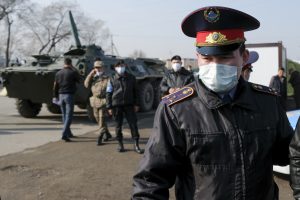The coronavirus pandemic has presented a major test of domestic and international governance. Central Asian governments rank low on global indices of state capacity and freedom, both of which are important factors that determine the effectiveness of measures to manage the pandemic.
As experts have rushed to offer insight on how states are handling the crisis, predictions about Central Asia have been pessimistic. One Foreign Policy article focused on the lack of transparency and crumbling healthcare infrastructure in Central Asia and concluded that the “prognosis for this precarious region” is grim. A PONARS memo categorized former Soviet states’ political responses to the pandemic – specifically public communication and restrictions on movement and public gatherings – according to when they were implemented.
The subtle implication of grouping states this way is that later responses are ineffective responses; essentially, state capacity is a function of time. Armenia and Georgia – which shut down schools in the first days of March – are early and active responders, while Uzbekistan and Kyrgyzstan are “laggards” because they did not report cases until mid-March.
But pessimistic intra-regional comparison offers little, on its own, in the way of analytical or predictive power. Granted, the governments of Central Asia share legal and institutional legacies from the Soviet period, and there’s certainly plenty worth criticizing about policy in the region. However, this narrow, geographically-determined perspective is short-sighted.
How should we make sense of the region’s response to the pandemic, then?
First, it is more productive to focus on the effects and implications of specific practices, rather than structural features or analytic categories. For example, it’s easy to group state responses by regime type, arguing that democracies are better equipped to handle a pandemic based on institutional features. But the capricious, piecemeal approach to governing under lockdown has shown that even in countries widely considered democratic, citizens are making tradeoffs between freedom of movement and privacy.
In Israel, for example, the country’s domestic spy agency has turned from monitoring extremists to surveilling cell phone data to monitor the COVID-19 outbreak. Meanwhile in Uzbekistan, authorities are confiscating mobile phones from those in quarantine, citing a need to limit the spread of fear and disinformation about the virus. Taking a narrow look at countries based on region or regime type means missing similar practices that could persist even after the pandemic is over.
As such, it’s important to take a broader comparative frame. The Foreign Policy article mentioned above suggested that authorities in Kazakhstan were trying to cover up the virus’s spread by restricting entry to foreigners, and this suspicion might seem justified when situated with the response of neighboring countries. But decisions to restrict international movement in Kazakhstan, Kyrgyzstan, and Uzbekistan seem less like a coverup and more like a sensible preventative measure when compared with Central American countries, for example. In El Salvador, for instance, the president ordered a full lockdown before any cases were reported domestically. Kazakhstan, Kyrgyzstan, and Uzbekistan are far from the only countries in the world to restrict international travel or close borders in response to the pandemic.
Moreover, many of the critiques of Central Asian responses to COVID-19 – such as the sorry state of health infrastructure or public denial of the scale or severity of the pandemic – also apply to richer countries in the West. As doctors in Kyrgyzstan wear raincoats to work, nurses in New York repurpose trash bags as protective gear. If the virus is a great equalizer among individuals – the main takeaway from Albert Camus’s novel The Plague – it can also be a great equalizer among nations.
Finally, although many elements of Central Asian politics are worthy of sharp criticism, it is also constructive to consider what countries in the region are doing well. Uzbekistan stands out in particular. Despite the resource constraints facing its health infrastructure and a very recent history of repressing unflattering or critical information, Uzbekistan has pushed for transparency and wide access to information. A state-run Telegram account that exclusively publishes coronavirus updates has more than 1.2 million subscribers, and the government is providing internet and cell service free to those who don’t have access.
In the long term, it will be necessary to identify and push back against repressive measures that were deemed acceptable in the name of public health during a time of crisis. But for now, it is more productive to emphasize the small successes, share best practices wherever they arise, and seek creative ways to govern through chaos.

































